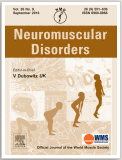 Fingerprint bodies are observed in a variety of clinical situations with no definite genetic cause identified so far.
Fingerprint bodies are observed in a variety of clinical situations with no definite genetic cause identified so far.
The French clinicians report for the first time the association of fingerprint bodies with rods in a patient who developed a slowly progressive myopathy affecting the face and limb extremities. Ultrastructural examination first disclosed fingerprint bodies and on a second biopsy, associated cytoplasmic bodies and rods. Next Generation Sequencing panel of congenital nemaline myopathy genes allowed the identification of two novel variants, a deleterious missense variant located in the WASP-homology 2 domain, and a deletion in the LMOD3 gene, generally causing severe nemaline myopathy with antenatal onset and early death. Recently, a less severe phenotype similar to our case has been reported.
This study confirms the existence of milder phenotypes linked to LMOD3 mutations and underlines that fingerprint bodies, though not specific, may be an early ultrastructural marker that could be linked, among others, to nemaline myopathy.
